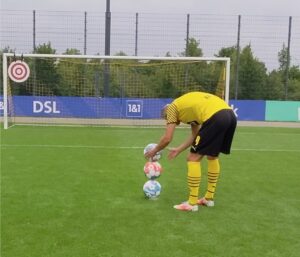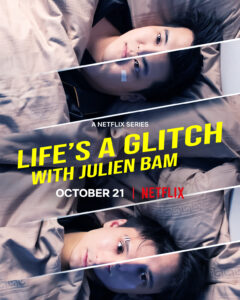“Believable Lies” – Min Tesch on the Art of Visual Effects. Interview by DENG Qi
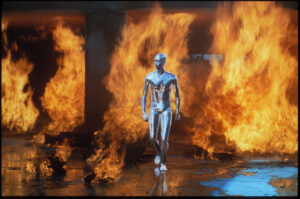
A visual effect that left a deep impression on the young Min Tesch: the ‘liquid policememan’ in Terminator 2 (1991)
Hi, Min. How are you?
Hi, Chelsea. I’m okay, thanks. I was looking forward to play some soccer later today, but when I woke up this morning, my heel was swollen, out of nothing. No idea why. It really hurts when I step on it. So no soccer today. I’m a little frustrated.
Well, good for me, so you have some time to give me this interview. Maybe you should go to the hospital!
No, no, it’s fine, nothing big.
That’s a typical male answer.
Maybe, but what will they do? Put some balm on it or tell me to rest a little and to not stress it? It’ll be fine. Just give it a few days.
Ok, let’s leave it at that. Although it’s interesting – I guess you heard about Achilles’ heel, right? Anyway, get back to me when they have to take it off. So what are you working on at the moment?
Currently, I’m not working on any film project. I’m doing my lectures for IFS (International Film School) here in Cologne, in the VFX & Animation Department, where I’m teaching two project classes at the moment, plus an introduction to Nuke.
Nuke is a software?
Yes, it’s a compositing software.
What was the last film you worked on?
Let’s see … That was a German TV series about people in the mountains with helicopters and stuff. A rescue team in the mountains.
Was it a challenging project?
Every project is somewhat challenging.
Many people have the wrong idea about your profession. How would you define what a VFX artist is?
Actually, it’s not really possible to describe it in one sentence. Of course we do a lot of green screen stuff, where we replace the background with cool landscapes – deserts or ice planets or whatever. But that’s not the main work. I do a lot of things that you can’t actually see, just enhancing the picture. If I’m good, you don’t even notice it.
Today no film can do without VFX, is that correct?
Not quite. Yes and no. I think lot of films could do without VFX, but in fact, nearly every film ends up using them these days. Maybe just a few independent productions don’t go for it. It’s understandable, because if you want to support the cinematic illusion, VFX is just perfect – not to mention the repair work we do, for instance fixing continuity problems. You cannot control the weather when you shoot outdoors – on one day, the sun is shining, and on the next day it’s rainy, so the images don’t match. We make sure they do.

Min Tesch has more than eighteen years of professional experience in the fields of feature film VFX compositing and on set supervision, TV commercial compositing and editing, motion design and art direction. After receiving his B.A. in Visual Communication from the Maastricht Academy of Fine Arts, he volunteered at MV Central, to then work as a freelance digital compositor, 2D/3D animator, VFX supervisor, VFX artist for international tv and film productions like Stowaway (2021), 7500 (2019), Brecht (2019), A Hologram for the King (2016), Colonia (2015), the German Netflix series Dark (2017) and many more. Since June 2017, he teaches visual effects at IFS International Film School Cologne. Photo: private.
When most people talk about effects, they mean something visible, something spectacular. But you just said that most of the effects you do are quite the opposite. You hide stuff, and you even try to hide that there are any effects in the movie at all.
That’s true. A lot of effects support the narrative, the illusion that a film gives. Imagine yourself watching a film and all of a sudden you see a reflection of a cameraman in some window – you realize that this is a film, that you are watching something that is shot and edited, and that creates a distance most filmmakers – and most audiences – don’t like. Which is kind of funny, because we all know that we are watching a film, right?
Other examples are of course when you have an actor who is playing a dead guy, and his eye is blinking. Maybe it’s just for one frame, but if you see this, it’s the illusion that is dead, not that guy.
What types of ‘hide effects’ are there? Are there any categories? I could see in your showreel that you have been hiding lots of ropes that secure actors in risky action scenes, when they are for instance walking on rooftops and things like that.
We call those ‘hide effects’ retouches. Like in: touching the picture again.
What other categories are there?
Compositing is the generic term, then there is 3D integration, and matte paintings.
I heard many directors have been become really lazy on set because they think: ‘Oh, we got all these VFX guys, we can fix everything in the post.’
(laughs) Well, kind of, but not really. It’s always a question of time and budget. Take that reflection of the cameraman in the window again – you can hide that easily on set, the guy has just to take a step to the side and it’s gone. But when you have to do it in the post, it costs real money. So in bigger productions, it’s okay when the director says “I just want that shot, I don’t care about the reflection, we can remove it in the post”. So what you say about ‘lazy directors’ is somewhat true for bigger productions.
So that’s good for your profession, right? Because it creates jobs.
Right. The demand for VFX is still very high, and it is increasing, it grows every year. And to compete internationally, you have to keep every production on a very high level. When Netflix and Amazon produce a series, they are being shown in the whole wide world – everywhere. Traditional TV programs aim at a domestic audience. And that was also true for many films back then, they were only shown in one country. But if the whole world is watching, so to say, if you operate on a global scale, of course you have to work a lot harder to guarantee a certain level of quality.
Also, we have seen so many visual effects on screen – we gotten kind of used to them, to that standard, so everyone wants to top this. Think of a Marvel production like The Avengers: Endgame, where you have hundreds of VFX artists, maybe even thousands of VFX artists working together to make the film even more spectacular than the one before.
What do you think is the best method to review visuals for corrections?
I’m not sure I understand the question correctly. Do you mean an acceptance system, how to talk about such VFX and have them accepted by customers?
No, but just tell us about that instead.
There are two great tools made for that – one called ftrack, the other ShotGrid. These are tools where you can upload video clips, annotate and write into the picture what you don’t like, what you should change. This annotation then goes back to the artist who makes the changes.
Many people have difficulty in time management. How do you prioritize multiple projects to meet all deadlines?
This is also perfectly handled by these two tools. You can put in each deadline, prioritize each project, put people and capacity on certain tasks so you can get it done most of the time and have an overview to see when which deadline is and so you can get all the stuff done in time.
What was your most challenging visual effects design?
Phew, I can’t answer that so easily. But it’s always very challenging for me when a shot comes back again and again, that is, when you send off version after version and the client keeps asking for changes. Sometimes the shirt is supposed to be green, then a little blue, then purple again, and so on. There are shots where you send 50 to 100, on large projects even well over 100 different versions to the customer until he finally says: “Ok, this is the version I’m taking.”
Maybe they should decide beforehand which shirt color they want.
Next time I call you and then you please tell them that!
You have a 18-year experience in feature film VFX compositing and on set supervision. Is there an episode in particular that made you grow? What made a breakthrough in your career?
A particular point where I say ‘Here I made a big step’, I don’t think ever was something like that. Every project, every new company you work for is challenging. I went through a big evolution after I went from just compositing to supervising. Working with directors, cinematographers and a complete film crew is very challenging, humanly and also professionally. And the work is totally different from sitting in front of your computer and being your own boss and having everything in your hands. There are rules on the set and it’s sometimes very chaotic – learning to deal with that took a lot of energy. That’s why there aren’t that many people who do both. The people who decide to do supervision usually only do that, but then later they don’t work on the shots themselves. I still love creating images though, so I decided not to give up posting myself completely.
You are an artist and also a freelancer/director of the documentary Rem Koolhaas – A kind of Architect. What is your advice to students who want to become future freelance writers and make documentaries?
Let me answer that in a more general way if you don’t mind – I don’t know much about the specific career path of a writer or a documentary filmmaker. I think it’s always important to be totally and wholeheartedly behind what you’re doing. You should never be primarily concerned with the money, no matter what field that is, whether it’s a documentary or a big feature film. To be successful, it’s important to stand behind your ideas and see them through.
Tell us a little bit about your project for the DFL, the German Football League. How did you come up with that idea?
Normally, I’m just working for film productions. This time, I produced for social media, so the whole approach was completely different.
A first attempt at trying out the possibilities of VFX clips for social media platforms: Min’s son Levi acting as ‘the Godzilla Kid’
I had done a few clips with my kids, just for fun, just to get a feeling of how the workflow is when you’re producing something for a platform like Instagram. A friend of mine who is working for the DFL showed those clips to some of his colleagues – and they really liked them. So the DFL approached me and asked me if I could do some of those for them.
I am always interested in new media developments, and I found that whole social media thing really interesting – but it was completely new territory for me, because this whole thing is just a few years old, I had never learned anything about it at the university. So I had absolutely no clue about the whole thing when I started – what are the possibilities, what can you do with those media? And where are the limits? I had to come up with all ideas on my own. I watched our hours of hours of Instagram reels and TikToks to get a better idea what I can do, and also to find some inspiration. And I was really impressed by the content these people create – how boring an old medium like TV is compared to that! There are so many great creative ideas out there, all you have to do is to pick them up and translate them into something new, transform them – I like that word, because it basically means you take a form and then transport it to another place.
One thing I found was done by an Asian guy, he put a huge table on top of a really small bottle – as if all he had to do is to find the right balance. Loved it. And I thought, this could be done really easily with VFX.
So you weren’t sure whether that was already VFX?
No, I wasn’t! That’s why the clip worked so well, that’s the whole idea, I think, that all he had to do is balance it out really well – because it takes him ages, you know, he goes back and forth. Beautifully done. So I tried to apply this to these football clips – in this case, putting three balls on top of each other.
Which is what we see in the clip you did with this famous BVB player, Erling Haaland.
Right. But I also tried out a few other things. I asked a friend to help me with that, we went to a football field in the neighborhood and made sure that all these ideas actually work, and even more importantly, that they can be realized really quick.
After I did that, I showed those clips to the DFL guys, they liked it a lot and then told me that we have to do it with some real stars like the one you just mentioned, Haaland, or Robert Lewandowski from Bayern Munich.
Wow, Lewandowski is famous in China, too. How was it to work with these people? Did they act like divas? Was there any difference between, say, a Bayern Munich player and those of Dortmund? Who did you like most?
Working with superstars like Haaland or Lewandowski is really special, because their time is so valuable. Every football star had just three minutes to produce these clips with me. That’s really not much. Normally, you have half a day for a shoot like that, but these guys earn more in these three minutes than I earn on a whole day. So time was the biggest challenge in that project. I had to plan everything really, really well. Sometimes we had just one take – and if that didn’t work out, that would’ve been it. So I think I could’ve done a better job here and there if I would have had more time. But considering the circumstances, I am quite happy with the results.
About the differences between these players, well, everyone is an individual of course. Maybe the biggest difference was age. Most of the younger players were really excited about doing this, because they are new in that business. The older players were more like: Ok, that’s part of my job, let’s get it over with. But maybe they were also not that enthusiastic because they didn’t know what the end product would look like.
I also noticed a difference between these two clubs, but I rather keep that observation to myself. Let’s put it that way, they do have a different culture, a different approach to things. But everybody knows that anyway – the BVB is not Bayern Munich et vice versa.
So far, only one of them was released, correct? The one with Haaland.
Yes, that’s true. They will put them out one after another.
Do you have a favorite?
No, I kind of like all of them. But what I like even more are the first clips I did with my friend on the football field, just to practice.
Rehearsal.
Yeah, kind of. Training. Because the challenge for me was to figure out: How can I produce these clips? I wanted to arrive at the highest efficiency with the least effort. So in my eyes, this test project was already a success. When I finished it, my friend and I were sure that I can produce these clips in a sufficient quality within a short amount of time.
Some of the German media went crazy about the first clip. The German BILD-Zeitung even speculated: Real or fake?
Yeah, they came up with all these crazy ideas how this was done: that the balls were not inflated and that this was why they could be stacked, or that the balls were actually one behind the other and only looked as if they were stacked due to perspective distortion etc. So that was fun.

Article in Germany’s BILD-Zeitung: “BILD solves the puzzle for millions of football fans: The Haaland video is fake!”
But what I found really exciting was that the Haaland clip went viral shortly after he put it up on his website. To see that more than 200 million people had watched this little clip of mine, that gave me a great feeling. Normally, when you work on a big movie project, you are like just one person working within this huge team of other people – if you’re lucky you are able to see your name in the credits, just for a second. But for this project, I was the only one producing it – from the initial idea to shooting it to post production. So it was really my work, and to see this going viral made me very proud.
The BILD-Zeitung kind of nails it: The Haaland video is fake. Visual effects, that is simply ‘faking it’. Would you agree?
(laughs) If you look at it this way, then any film or novel is ‘fake’. Even your dreams! So in principle you’re right. But would you call Shakespeare’s or Hemingway’s stories ‘fake’ because they made them up? I guess I’d reserve the term for matters of deliberately decepting the public – when it is about fooling people to gain political support. Of course, any fiction needs to be convincing. But in the case of ‘fake news’, they pretend it’s real, they try to convince people that this stuff is taking place in the world we live in. Sure, the football clips I did want to make you wonder: “Wait a minute, really?” In other words, the lie must be believable. But not true! The problems begin when a lie poses as truth. And claims factuality. I’m not doing that, otherwise I wouldn’t be sitting here talking to you about how I did it.
Ok, let’s switch to another topic. If you would have to name your top five visual effects of all time in the history of cinema – which would those be?
That’s a tough one. I mean, in a movie like The Avengers: Endgame there’s so many effects, you have a hard time counting them. So I can’t really say which effect I like most.
What about the spaceship landing in Prometheus? When it first lands on that planet. I heard they worked on that one forever?
There is a shot breakdown of this one on the net (https://www.youtube.com/watch?v=BumNl-a449g, minute 1:10). For example, you see how they built the space and the landscape, etc. – and in the actual shot you only see the smoke and nothing more of all the other stuff.
The effect and also the whole film I don’t find very remarkable. It is also almost 10 years old and already back then wasn’t that great. But there are certainly some movies that had a great impact on me.
First of all, Terminator 2 – I think it’s still one of the best films combining digital and practical effects, they blend in so well.
You call practical effects SFX, right?
Yes, that’s correct.
Shouldn’t it be called PFX?
True, actually. The ‘s’ just stands for special.
What’s the definition of a practical effect?
Well, you usually have to do it on set. A car crashing into another car, that’s a practical effect. Anyway, my favorite effect from Terminator 2, one that everybody remembers, that’s the liquid policeman. It’s still so great to see that. And everybody identifies that effect with the film, although there’s just about 20 seconds computer generated footage in the whole film. The rest is all practical effects. Then there’s Peter Jackson’s Lord of the Rings trilogy. There are so many great effects in that, and so many of them, and they still hold up quite well today … All these massive fight scenes between the Orks and the humans. Fire, water, it’s all done so well, and it’s almost 20 years old. That’s another thing about effects, they usually have a very short life span. And every year a new movie comes out that perfects them, that has better effects in them. For instance, I used to like Twister very much, a movie about about a hurricane in the US, and when you see it right now, it is really horrible. But back then, it was quite spectacular. It has cows in it that are flying through the air and stuff like that. Noone had seen something like that before.
What do you think about the special effects the American government used for the television production of the first lunar landing?
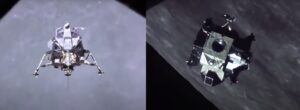
Screenshots from “Apollo – The Moon Mission” (2020) showing original footage of “the greatest single broadcast in television history” (Walter Cronkite, CBS anchor)
(laughs) Well, I know what you are trying to get at here, the ‘moon hoax’. But I’m not sure, you know. Because noone has any idea how things actually look like in space – how they move, or about the light conditions. Our only reference are all these space films! I’m not saying the Americans landed on the moon, but I’m also not saying they didn’t. I wasn’t there!
But if you just look at these images, stills from the first moon mission? What does the VFX artist in you think about it? Convincing? These are very nice models, no?
These two images look indeed strange, of course. However, they have been processed afterwards. You can see this, for example, in the fact that no more film grain is visible. Then the first questions arise: When was the material digitized? Since it is in HD, this can only have happened in the last 15 years. What post processes were run over it? Removal of noise, additional sharpening, etc. This alone can create this strange look. And again – we have no reference how this actually looks! We only have these pictures that say: this is real. So I’ll buy it for now, just assuming that they didn’t ‘fake’ it. But I am happy to take a closer look at the footage one day.
Ok, back to your favorite films …
One of the more recent films I liked a lot was Villeneuve’s Dune, because the effects were more in the background, they served the story, the overall atmosphere, one didn’t notice them right away. And they were also much more realistic than in many other films.
But I also like the Snyder cut of Justice League very much, this dark, gloomy atmosphere he created there.
Don’t you think it is a little long?
It is! But it has to be. This is an epic, it needs time to unfold, because we’re not dealing with some funny superheroes here anymore – these are gods, the true ‘Eternals’, if you ask me. I think of it as a kind of VFX poem – it’s not so much the story, it’s these grand images he gives us, most of them would also work alone just perfectly. Just think of those Christ-like images of Superman standing in the air – that’s an icon that Snyder created, before that he was always flying back and forth all the time.
Have you seen Julian Bam’s Netflix series? What do you think of that? He’s quite a famous social media guy in Germany, right?
Yes, he is. Julian Bam was one of my first social media experiences – I thought it was great what he put out there every week, super imaginative, super fresh, completely different from the conventional entertainment you know from TV. The new generation of media makers, really great. It impressed me and inspired me a bit. But that was a few years ago.
But to be honest, I just saw the first episode. Then I stopped.
Why?
Well, the picture quality and everything is really great, so it’s definitely a production that can compete internationally. But of course Julian and his friends are no professional actors, and what was really charming in his own little films on Youtube doesn’t really work in such a big series on Netflix. For me! Others may see that differently. Some people may find it charming. To me, it feels – quite ironically, because Julian Bam was the alternative to TV back then – like German national TV. Like some comedy sketch show on ProSieben.
Are there any animations in the last five to ten years you found groundbreaking or innovative?
I think every Pixar film so far has been really innovate. I haven’t seen Luca yet, my kids somehow don’t want to watch it, I have no idea why – but these are always great, they tick all the boxes for me: inventive, highly intelligent stories, most of them have a certain depth to them … I mean, think of Coco, a film about death – for kids! And the way it adapted Mexican culture, these old religious traditions, the music – I don’t know how one could do this any better. But they’re also great when it comes to the technical level. The way they animated water in Finding Nemo, that was really state of the art back then – an art that didn’t even exist yet, they created it!
I also think that the Netflix series Death, Love & Robots was great, because every episode was so unique, it showed the richness of the world of animation, what is possible right now, both in style and technique. Recently I came across this series Arcane on Netflix.
Thats a story from League of Legends!
Yes, it is. That’s big thing in China, right?
Yes, it’s one of the most successful PC games here.
Well, I really loved that style – it looks as if its hand-drawn, but it’s in fact animated. Beautiful.
What I find interesting is that stop motion has made this huge comeback. Why do you think that is?
I wouldn’t say it’s a comeback, it has always been there, but the productions are much bigger now, because it’s a very expensive thing, and to keep up with the animation stuff, they have to produce it in better quality. But there are just a few studios that are really, really great at that, like Aardman, which produced Shaun the Sheep and Mr. Link. That is really great because they can extend their worlds with CGI now.
As I said before, no movie can do without, not even stop motion! Ha!
Okay, okay, you’re right. Kind of. Let’s just say that even stop motion uses VFX now. There is another great series on Netflix, The Dark Crystal. That’s a puppet series which is also analog, with really great VFX extensions. That’s also done in stop motion. So it’s not a comeback, but there is a computer animation – with famous directors like Wes Anderson doing stop motion films. I understand that, the people don’t want to see only computer animation all the time. Stop motion gives them a different feel, a more natural, human one I guess. I guess you could say stop motion, that’s the Arts & Crafts of today (laughs).
What do you think of horror theme animations like Coraline or so-called satirical reality like Rick and Morty?
Personally, I like Rick & Morty a lot, but now we’re of course entering a completely different terrain, that is, the content of animation films. Also, there seems to be a certain skepticism in your question. So maybe I should rather ask you what you think about those films?
I think it can be kind of misleading for young kids because of the picture they draw. But it can be justified. For instance, in Coraline, there is a locked door, behind which the ghost mother lives – and this world is more beautiful and more harmonious than the real world where Coraline lives. I understand that it is a critique of this desire for profit in real society. So, what do you think?
So you’re afraid it may do some harm – like ego shooter games turning nice kids into assassins, or isolating young girls from the real world. This debate is as old as the media. When the first books where printed, people thought these stories may turn brave housewives into sex-hungry nymphos. You need to ask some media sociologist about these things – I am a little skeptical. All I can say is that I like Rick & Morty – not so much because of the way it’s drawn. What I like are the stories, so I guess exactly what you find problematic, this ‘satirical reality’.
To what extent do you think animated films should reflect reality and why?
I think animated films are made to tell stories that are not like reality. That’s the point, isn’t it? So it’s a totally different approach. That is why fantasy stuff works so well here. If I want to tell real life stories, I’d go for real actors, real settings, no blue or green screens.
So to answer your question: I don’t think animated films should do that at all. The interesting thing is that a fantasy story like Dune works so well because the effects look real. So this is a kind of contradiction: for such a fantasy world to be convincing, it should be as realistic as possible – that is, it should take into account certain physical laws. We already talked about this.
It needs to be believable.
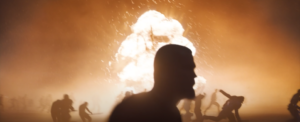
Screenshot of a scene from Dune: Josh Brolin’s face is dark, as if the camera isn’t able to properly expose both the explosion and the face – which is exactly what would be the case in real life.
Yes, and that’s what Paul Lambert and his team achieved. So, for example, if a person is standing in the backlight, his or her face should be dark, right? If, that is, you want a realistic feel to it. Because that’s what would happen in the real world. That’s what they did in this night scene, when the base is attacked, and the bombs go off in the background – you cannot recognize the faces or any other details of the people running, all you see are silhouettes. And the effect is that these ‘fake’ explosions, as you’d call them, look real. Many Marvel films don’t want that. They want to show-off, they go for the unrealistic, for weird camera movements that wouldn’t be possible in the real world.
I once animated an explosion, and somehow it didn’t seem convincing – until I made the image vibrate, just like a camera would vibrate when the shock wave of the explosion hits it – suddenly it worked.
That’s what you did in this little clip with your son, too! The moment he stomps on the earth, the image vibrates.
Yes, that’s true. It just adds to the illusion.
In the end, it’s a question of taste. And what story you want to tell. Apart from that, a film like Finding Nemo doesn’t represent or reflect reality – fish don’t talk, right? But at the same time, it’s a great allegory on friendship, on family, on our fears and anxieties and how to overcome them – just what fables did back then.
So a film doesn’t have to be realistic to reflect reality. Even when it’s a crazy, weird over-the-top series like Rick & Morty, which is basically about a relationship – I guess a relationship between a student and a teacher, a travesty of what this normally means. And of course it’s also pop culture, a clear reference to Zemecki’s Back to The Future. I mean, it’s not hard to figure out that the relationship between Rick Sanchez and Morty Smith is similar to Doc Brown and Marty McFly from Back to the Future, is it? Why should a teenager hang out with a mad scientist? My answer is: because that’s the case in Back to the Future. It’s a reference.
I heard that the basic plot was conceived out of Justin Roiland’s earlier Channel 101 ideas titled The Real Animated Adventures of Doc and Mharti and that it started out as a parody of Back to the Future. But I never saw the original.
You absolutely should! Not so much because of the effects though.
I heard you are big fan of TikTok, is that true?
I wouldn’t say I’m a big fan of TikTok, but I watched it a lot recently, because – as I already said – there are so much people who produce really unique and creative content – and I really like that. People doing things on their own, individually, and also autonomously, without the filter of some media house or a big production company. That’s the spirit of punk: Everyone can produce. Or the spirit of Beuys if you like: Everyone’s an artist! (laughs) It’s creative content without any big budget. So you see people producing on the home computers or just on their phones some really, really cool stuff, That wasn’t possible some years ago.
What I find problematic about TikTok is the fact that there is so much content. You have to go through a a lot of crappy stuff to find the good stuff. It takes a lot of time – time that I usually don’t have.
All the more remarkable that you have taken the time talk to me. Thank you and good luck for your future projects. Call me in case they want to change the t-shirt color for the 50th time.
Interview: DENG “Chelsea” Qi (with a little help from A. Khan and M. Heidingsfelder).
Link to Min Tesch’s website: https://mintesch.de/
